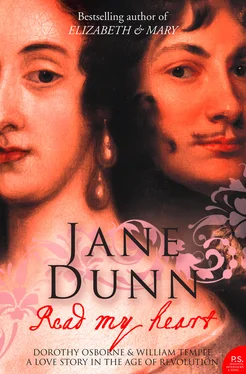In the bitter February of 1645 with the castle down to its last week’s bread rations, Dorothy’s aunt, Lady Gargrave, set out for St Malo with some of Sir Peter’s clothes and a couple of trunks of the family’s linen to try to pawn or sell in order to purchase provisions. Within six days this doughty woman set sail on her return journey to Jersey with a boat full of supplies but was chased by pirates ‘and narrowly escaped by running with great danger among the rocks’. So alarmed was she by the prevalence and zeal of the pirates in the area, she asked Sir George Carteret to loan her one of his experienced seamen to help ensure a safe delivery of the provisions to Castle Cornet. This he apparently refused her. Instead, he wrote a letter to one of Charles I’s advisers suggesting the Osborne family were guilty of double-dealing. More shockingly, he accused them of possible betrayal of the king’s cause by citing various activities of Lady Osborne and her sister.
This brought forth a cry of eloquent outrage from Sir Peter against ‘these maliciously invented slanders’. He explained how his wife’s tireless efforts of fundraising had exhausted her: ‘For when her mony was spent, and plate sold, she made no difficultie among strangers to ingage her self in a great debt for the releife of this castle, till her credit at last fayled.’ What provisions Lady Osborne then obtained were left to rot in Jersey due, it seemed, to Sir George Carteret’s inertia, or worse. This frustration of her Herculean efforts seemed to be the last straw for his long-suffering wife: ‘oppressed with trouble and greife, she fell into a desperate sicknes, that her self, and all those about her, feared her life’. 28
It was possible that her eighteen-year-old daughter Dorothy was with her during this ordeal for, barely conscious, Lady Osborne was carefully embarked on a Dutch ship and accompanied back to England, a journey of two days of which she hardly noticed the passing. Dorothy was to write later of the harsh experiences she had endured in France and the lowering effect they had had on her spirit and demeanour, so much so that her friends on her return hardly recognised her: ‘When I cam out of France nobody knew mee againe … and that Country which usualy gives People a Jollynesse and Gayete that is natural to the Climate, has wrought in mee soe contreary effects that I was as new a thing to them as my Cloth[e]s.’ 29
The whole Osborne family was transformed very much for the worse by their experiences of war. Sir Peter Osborne had entered into his costly defence of Castle Cornet in 1642 when he was already fifty-seven years old, elderly by seventeenth-century standards. He was over sixty and exhausted in spirit, health and fortune when he eventually relinquished his post in the early summer of 1646. Lady Osborne’s pleas had some effect at last, although it was months before King Charles got round to writing about her husband’s plight to his queen Henrietta Maria, in exile in France. Uxurious and suppliant, the king asked his wife to release Sir Peter Osborne with the following letter dated 21 September 1646:
Dear Heart … I have but one thing more to trouble you with, it is, that I have received lately a letter from my Lady Osbourne, which tells me that her husband, who is governor of Guernsey, is in much want and extremity, but yet without my leave will not yield up his government; wherefore she hath earnestly desired me either to shew him some hopes of relief, or give him leave to make his own conditions. To this I have answered, that I would (as I do) recommend his relief heartily to thee, commanding her to direct her husband to observe the queen’s orders. So praying God to bless thee, and longing to hear from thee, I rest eternally thine,
Charles R 30
Sir Peter’s long and uncomfortable defiance at Castle Cornet was also a completely wasted effort with nothing good to come from it but the demonstration of his own uncompromised loyalty. There was no hope of reward or recompense and scant recognition. In October 1647 when Sir Peter had requested through his son that the king relay to him his commands, the reply came back: ‘I can give no commands, for I am now commanded; but when I shall be in any condition to employ his loyal affections, he shall know that he is a person I have a very particular regard to; commend me to him, and tell him I am beholding to him.’ 31 The king’s son Prince Charles had also vaguely promised some favour on a future occasion, possibly while he spent the summer months of 1646 in pleasant exile in Jersey, but Sir Peter died before his restoration as king in 1660. At that point, however, the newly enthroned Charles II had more pressing affairs to attend to. The diarist John Evelyn wrote an appreciation of him in which he recalled the shameful neglect of many hundreds of quiet heroes like Sir Peter Osborne, uncomplaining and unsung, while Charles II indulged his rapacious lovers and favourites: ‘An excellent prince doubtlesse had he ben lesse addicted to Women, which made him uneasy & allways in Want to supply their unmeasurable profusion, & to the detriment of many indigent persons who had signaly serv’d both him & his father.’ 32
The father Dorothy greeted at St Malo after he had sailed away from Guernsey for ever was much diminished. His health was broken, his estate confiscated, his fortune beggared. His loyal wife’s own health and peace of mind had suffered too, his daughter Dorothy had lost her hopes and his family of brave sons was reduced by two, the promise of their youth and the pride of his old age destroyed in the random violence of war. The Osbornes’ plight was by no means unique but it would affect them all profoundly. Above all it made it imperative that their last daughter to marry should make an alliance with a man of property and conventional prospects to help restore the family’s status and fortune.
*An officer of the exchequer responsible for collecting debts due to the crown, the term probably dating from a time when these transactions were remembered rather than written down.
†Milton was some twenty years older than Dorothy Osborne and published his great works during her lifetime. In Sonnet XI he honoured the scholar: ‘Thy age, like ours, O Soul of Sir John Cheek/Hated not learning worse than toad or asp/When thou taught’st at Cambridge, and King Edward, Greek.’
*Thomas Brightman (1556–1607) had a great influence on the Puritan movement in England. Educated at Queens’ College, Cambridge, he was a modest man, a fine scholar and a fiery preacher. Brightman chose to remain unmarried, ‘preferring a bed unfilled to a bed undefiled’ and died suddenly, as he had wanted, on a summer’s day and in the company of his benefactor Sir John Osborne while they were bowling along in the latter’s carriage.
*John Aubrey (1626–97), antiquarian and writer best known for his brilliant extempore biographical sketches collected as Brief Lives and his recognition of the importance of Avebury and mapping of the prehistoric stones, which he showed to Charles II in 1663, the same year he became a member of the Royal Society. His wide friendships, warmth, curiosity and charm made his writing uniquely informative and entertaining.
†Lady Osborne was Elizabeth Nevill, daughter of John Nevill, 4th Lord Latymer. Born before 1552, she died in 1630, thirty-six years after her first husband Sir John Danvers.
*Sir Edmund Carey (1558–1637), son of Elizabeth I’s cousin (some said her half-brother) Henry Carey. Once married to Elizabeth Danvers he worked vigorously and unscrupulously to attempt to save the Danvers estates from the crown. They had been confiscated when Lady Danvers’s son and heir, Sir Charles, admitted his involvement with the Essex Plot and was declared a traitor.
*As this was the equivalent today of more than £1.25 million per annum it becomes obvious why his stepfather Sir Edmund Carey worked so assiduously to try to save this estate from the crown when Sir Charles Danvers died a traitor. Lord Danby gave Oxford some of his land in 1621 to create the first ‘physick garden’ in the country with the stated purpose ‘to promote learning and glorify the works of God’.
Читать дальше












